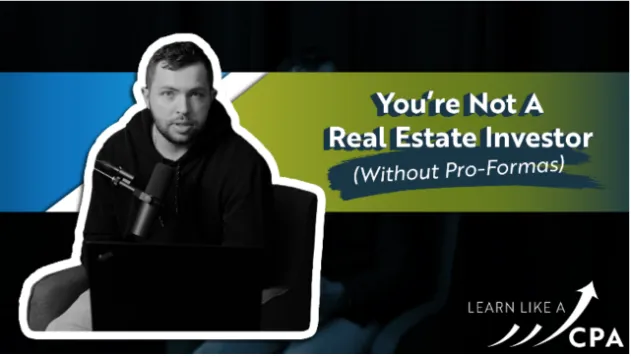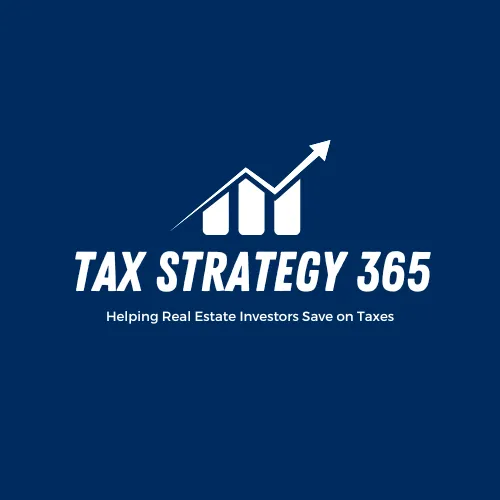Latest blogs and articles
Leading you to a better financial future.

You're Not a Real Estate Investor If You Can't Run a Pro-Forma
You're Not a Real Estate Investor If You Can't Run a Pro-Forma
Are you best friends with pro-formas? If you are a real estate investor then you really should be. Don’t know much about pro-formas? Want to learn more? You’re in the right place. This week’s LearnLikeACPA podcast is dedicated to a deep dive into this crucial subject.
What are they?
Pro-formas should be thought of as mock financial statements. They’re a way to pencil in the numbers to insure that a deal makes sense. Why aren’t you a real estate investor without them? Without running the numbers and doing due diligence, real estate is just a hobby. Successful investors find great deals, but also prove their great deals on paper. This being said, pro-formas are useful in more ways than one. If you go to an investor, pro-formas will separate your story of a great investment from the cold hard facts.
Let’s dig into some Pro-Forma lessons
Purchase price to gross revenue test
A good rule of thumb is that gross revenue should be 18-20% of the purchase price for a short term rental. A lot of people will want to use cash on cash return as their metric, but it falls short. There are numerous ways to increase or decrease the cash invested at the beginning of a deal, but the gross revenue test gives a better, more concrete assessment of how good a deal is.
Operating Expense ratio
Operating expenses are all the expenses before your debt payment. A healthy expense ratio here is between 35-50%. Why is the range so large? It depends if you are using a property management company. Even if these numbers pencil out, it is often a good idea to stress test - pushing towards the 50% mark to see if the deal makes sense. This is because in real life everything tends to take longer and be more expensive. Running stress tests will ensure that the deal has the best chance to succeed.
Tax Estimates
When examining a property it is a good idea to take tax reassessments into account. When properties are sold, the tax burden on them is reassessed. This means if a property has been owned by one person or entity for a significant amount of time, the taxes you will pay when the property is purchased could be significantly higher than what they are currently paying. How do you estimate the taxes then? One method is to look at properties in the area. If properties of comparable size have comparable tax burdens, then you will likely be able to have a good estimate of how much tax will be incurred. It may also be important to take into consideration the land to building breakout. Typically the lower the land value, the better this will be for investors.
Insurance & Utilities
Get quotes on insurance before you buy. Also be sure to consider flood insurance. The current owner may not have flood insurance, but the property is located in a flood zone. If they have flood insurance, it may be transferable. Utilities should not be overlooked either. Does the property have a hot tub that needs to be cleaned? Will the property require pest control? These items are often missed but can add up quickly, so be sure to include them in your pro-formas.
Financing
This will make or break your deal. While cash on cash is not the best metric as mentioned above, it should be weighed against the cost of financing to decide if the property will produce income. All these evaluations are calculated by using percentages, and this may be the biggest take away. Many savvy investors will use these percentages to back into a purchase price instead of the other way around.
Let's look at a deal
I have a deal under contract. It is a million dollar property, currently a rental, which is providing 200K gross revenue. This meets the gross revenue test. Financing is 20% down on a 30 year loan at 6.5% interest rate. Property taxes $1200/month. Other operating expenses include insurance, utilities, airbnb fees, HOA, cable internet, automation, cleaning, repair and maintenance, pest control… I also include management fees. This makes these investments passive which is the ultimate goal.
If you want to run a test like this yourself, there is a template linked below to create your own pro-formas. Check your percentages and make sure they make sense. This is not complicated or glamorous, but pro-formas are the keys to the world of real estate.
You're Not a Real Estate Investor If You Can't Run a Pro-Forma
Join my Facebook group with over 9,000 real estate investors!

Choose Your Journey to Tax Excellence
Journey 1
Building a Tax Advisory & Consulting Practice
Scale, streamline, and systemize your advisory business.
Turn compliance clients into year-round advisory opportunities while mastering operational efficiencies for sustainable growth. This track covers pricing, hiring, marketing, and client engagement essentials to help you build a practice you love.
WHAT YOU’LL LEARN:
Crafting solid engagement letters and pricing models.
Transforming compliance clients into year-round
partners.
Marketing
strategies that drive consistent growth.
Recruiting and training the right team to scale your business.
Bonus:A Power Checklist for the ultimate year-end tax planning session.
Journey 2
Tax and Legal Foundations: Core Strategies for All Levels
Master the fundamentals that drive financial success.
Perfect for business owners and advisors, this track delivers essential insights on asset protection, tax planning, estate strategies, and IRS compliance.
WHAT YOU’LL LEARN:
Unlock estate planning with Revocable Living Trusts.
Maximize retirement savings through Solo 401(k) plans.
Real estate strategies: Short-term, long-term, and self-rentals.
Learn asset protection that actually works.
Navigate IRS resolution with confidence and ease.
Journey 3
Advanced Insights: Unlock Complex Tax Strategies
Top-tier strategies for high-value clients.
Designed for experienced professionals, this track offers in-depth guidance on prime tax strategies, entity structuring, and payroll solutions. Gain the insights needed to handle complex business scenarios with confidence.
WHAT YOU’LL LEARN:
Report multi-entity structures with Forms 1065 & 1120S.
Maximize tax savings using Bonus Depreciation & Section 179.
Seamlessly relocate clients to tax-free states.
Navigate business sales and acquisitions smoothly.
Use 105 Plans to save clients on healthcare costs.

2024 Learn Like A CPA. All rights reserved.